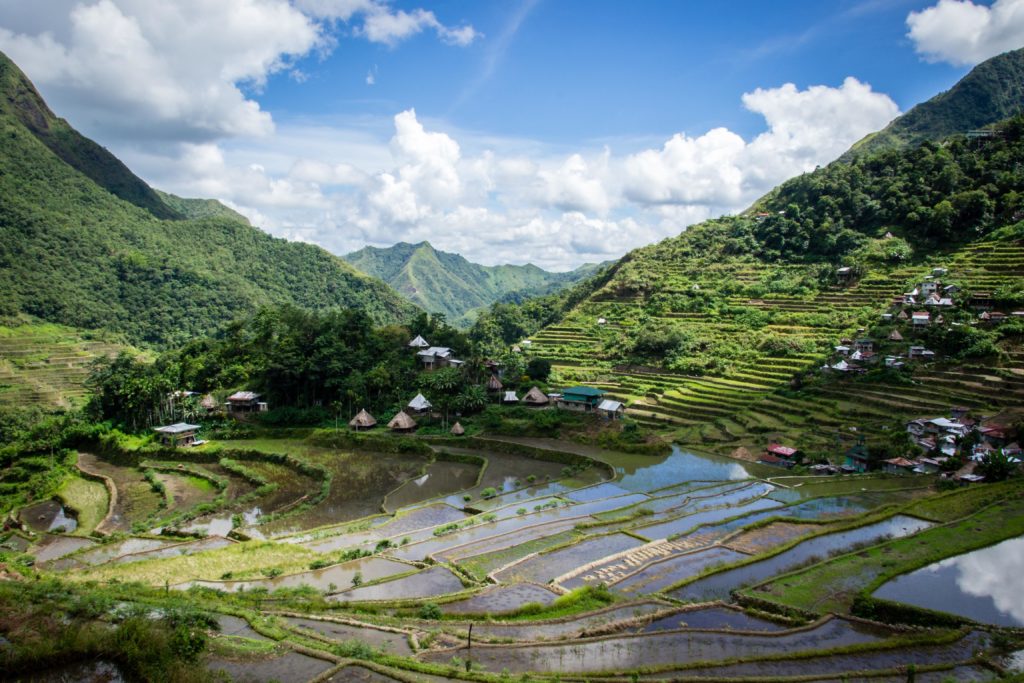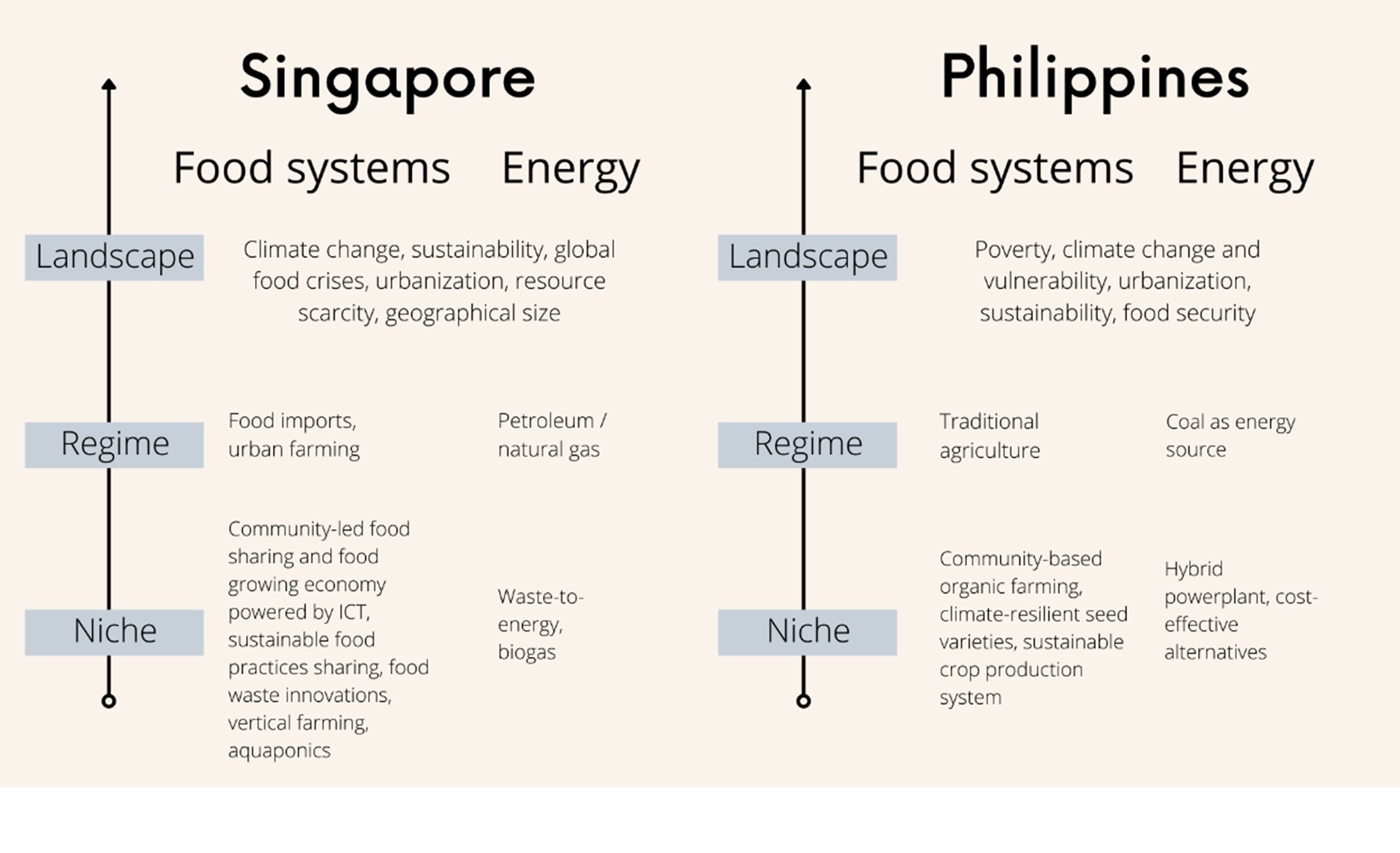Sustainability transitions in Southeast Asia: Challenges and opportunities with references to the Philippines and Singapore

DOI reference: 10.1080/13673882.2022.00001006
By Raissa Joplo, Master Student of the Master in Sustainability, Society and the Environment at Christian-Albrechts-Universität zu Kiel, Germany
Cities and markets transform to conform to shifts in global standards. These regulations seek to be part of a bigger, concerted effort to address resource limitations and climate change. This article will look at how “Sustainability Transition” unfolds to respond to the confinements and capabilities observed in case study countries. More specifically, this work looks at the sustainability transitions in two countries, namely the Philippines and Singapore. The research question guiding this analysis is: To what extent local contexts and practices could support sustainability transitions in Southeast Asia?
Sustainability transition is the process where challenging transitions and the fundamentals leading to change occur in cities and countries (Kivimaa et al., 2021). Transitions are not only mere chance, but exhibit measurements of analysis, distinguish different phases or stages and describe temporal scales (Fischer-Kowalski, 2011). Additionally, this process is a “long-term, multi-dimensional, and fundamental transformation process through which established socio-technical systems shift to more sustainable modes of production and consumption (Markard et al., 2012).” As a response to the curbing factors of development to meet global needs, sustainability transition is profound to the specificity and complexity of the local landscape. Sustainability transitions can be emphasized through a multi-level perspective approach (Kemp et al., 1998). This has three interacting elements – landscape (external environment), regime (elements shaping patterns in socio-technical system), and niche (space where novelties arise). Figure 1 shows the multi-level perspective elements presented in the case studies.
Figure 1. Presentation of the multi-level perspective elements discussed in Singapore and the Philippines

Food systems in Singapore and the Philippines
Being a country with limited territory size (approx. 719 sq. km) and natural resources, Singapore’s approach to utilizing resources and supplying high-quality food for its 5.9 million people is worth learning from. The technological innovations applied to the food systems of Singapore present a bunch of advanced techniques (Mok, et al., 2020) that transformed the industry, such as the expansion of vertical and rooftop farms and deployment of aquaponics systems, conversion of food by-products into yeasts cultivation, the introduction of new ingredients to food and beverage, improvement of safety and shelf life of food, production of biodegradable food packaging, research on alternative protein sources for food such as insect farming and cultivation of meat and microalgae. Waste-to-energy systems to deal with food wastes (Teng et al., 2019) are adopted for a sustainable and circular model approach.
Citizens themselves have begun harnessing the value of Information and Communication Technologies (ICT) to create a collaborative food supply system (Rut & Davies, 2018). The niche projects produced through this tool – Social Enterprise and the Collective – have provided alternatives for food production. The projects demonstrate the diverse contributions of conscious individuals to food sharing, food growing, community farms and gardens, and food waste reuse and distribution, among others. The construction of new ideas and activities for the public good stemmed from the individual values of these actors who aim to create a more radical system. To incline the system more into the sustainability dimensions and combat unsustainable consumption, the sharing economy must be recognized as a working framework and not just a mere alternative (Roxas, 2016). Moreover, it is important to note that the Philippines is classified as one of the most vulnerable countries to climate change. Agriculture, the main source of food, has been heavily affected by disasters over the years.
Farmers in the Philippines use more resilient crops that can withstand heavy typhoons and storms, to ensure a sustainable crop production system, such as sweet potatoes and the primary crop, rice (Baruah & Mohanty, 2020). Policies need to consider responsive mechanisms that will help farmers access new varieties of good quality seeds through efficient seed production and distribution systems, and also guarantee income. Through the country’s national organic agriculture policy, poverty is at the core of the problems causing environmental issues, which could be solved through economic growth and thereby leading to mitigation of these challenges (Suh, 2015). However, not much has been implemented yet. Relatively few programs have been done to support community-based organic farming and other activities that could make use of the country’s potential.
Energy systems in Singapore and the Philippines
Singapore is considering various aspects of shifting to renewable energy supplies from fossil fuels-based electricity sources. Among the existing waste-to-energy practices in Singapore is the use of biogas. This energy alternative would achieve the biggest environmental benefits for the country (Quek, et al., 2018). Tong et al. (2018) also concluded that the energy recovery of food wastes and brown water, which produce biogas, pose positive potential for the environment, without a large land area needed. The appropriateness of biogas in Singapore is also backed-up by Heng (2017) by presenting the first poultry farm which generates biogas for its own energy needs. Waste products such as chicken manure and used water are recycled for other farm needs or being treated for biogas production. This enables the farm to be self-sufficient and sustainable.
In reviewing renewable energy sources that could potentially work in the Philippines, one also needs to look at the poverty situation and status gaps in the country. There could be opportunities for optimizing greater returns to communities while responding to the telling realities of the people. One example of an initiative that pioneers a way how to incorporate social benefits is the Green Island project in Palawan, Philippines (Roxas & Santiago, 2016). It is a hybrid powerplant established by a public-private partnership. The device is composed of a biomass gasifier that runs an ice machine and a water desalination system, with a wind turbine and solar panel array. The powerplant provides uninterrupted power supply to communities at a lesser cost. The ice machine sells ice to fisherfolks, preserving catch before they bring it into markets. The desalination system brings affordable, fresh water to the residents. Whilst addressing the lack of electricity in the community, the Green Island project also delivers better livelihood and health impacts to the locals. This meets the sustainability standards that the country attempts to achieve. Nevertheless, a big part of the country still relies on fossil fuels. The utilization of coal is widespread because it is cheaper and more stable in supplying energy (Marquardt & Delina, 2019), even with the concerns of negative health and environmental impacts. The widespread understanding remains that renewable energy sources will only cost higher than the already existing source.
Conclusion and policy recommendations
Sustainability transition is such a complex case, considering how systems change in extraordinary, sometimes turbulent, ways. Science and society must study the socio-political narratives surrounding a given country to grasp the complexity of the dominant realities and contexts interacting in the grid (Wieczorek, 2018). For Singapore and the Philippines, the landscape and processes are unique. Actors involved in transition-related activities also vary. Both countries have historical economic and environmental narratives. The rate at which Singapore and the Philippines progress and evolve to meet economic demands and global sustainability standards is a difficult subject, with restricting comparative analyses criteria. When dealing with issues in the Philippines, it is certainly difficult to avoid the dimensions of poverty as this certain topic extends across varying sectors. Likewise, even if Singapore has the financial competence to implement technological innovations, the country continues to struggle with its territory size limitations. As the examples listed for both countries are locally oriented, the angle of grassroots communities is essential when concretizing national agendas. To conclude, I would like to state two main policy recommendations that are both relevant for Singapore and the Philippines.
First, the creation and implementation of sustainable policies should be evidenced by a clear connection to the current issues. The policies should be grounded on the differences in innovative potentials of countries in terms of industrial and technological specializations (Hansen & Coenen, 2014). With a strong recognition of the present landscape, the process of crafting policies will be appropriately directed toward the most suitable solutions. Second, allocate ample support to local actors and grassroots communities, utilizing modern tools and channels. People belonging to these groups are not only equipped with practical viewpoints but are also well-versed to determine what works and what does not. The investments in local talents and capital will not only better the lives of most people but will also help in executing equitable sustainability measures. As observed in more successful transition pathways, the role of political actors is significant in the process of achieving sustainability transition (Bai et al., 2010). With the impact and extensiveness of sustainability challenges these two countries are confronting today, sustainability transition makes greater relevance and should be included in national priorities.
References
Bai, X., Roberts, B., & Chen, J. (2010). Urban sustainability experiments in Asia: Patterns and pathways. Environmental Science and Policy, 13(4), 312–325. https://doi.org/10.1016/j.envsci.2010.03.011
Baruah S, Mohanty S. 2020. Smart Seeds for an Efficient and Sustainable Food System in the Philippines. CCAFS Report. Wageningen, the Netherlands: CGIAR Research Program on Climate Change, Agriculture and Food Security (CCAFS).
Fischer-Kowalski, M. (2011). Analyzing sustainability transitions as a shift between socio-metabolic regimes. Environmental Innovation and Societal Transitions, 1(1), 152–159. https://doi.org/10.1016/j.eist.2011.04.004
Hansen, T., & Coenen, L. (2014). The geography of sustainability transitions: Review, synthesis, and reflections on an emergent research field. Environmental Innovation and Societal Transitions, 17, 92–109. https://doi.org/10.1016/j.eist.2014.11.001
Heng, D. L. K. (2017). Bio Gas Plant Green Energy from Poultry Wastes in Singapore. In Energy Procedia (Vol. 143, pp. 436–441). Elsevier Ltd. https://doi.org/10.1016/j.egypro.2017.12.708
Kivimaa, P., Laakso, S., Lonkila, A., & Kaljonen, M. (2021). Moving beyond disruptive innovation: A review of disruption in sustainability transitions. Environmental Innovation and Societal Transitions, 38, 110–126. https://doi.org/10.1016/j.eist.2020.12.001
Markard, J., Raven, R., & Truffer, B. (2012). Sustainability transitions: An emerging field of research and its prospects. Research Policy, 41(6), 955–967. https://doi.org/10.1016/j.respol.2012.02.013
Marquardt, J., & Delina, L. L. (2019). Reimagining energy futures: Contributions from community sustainable energy transitions in Thailand and the Philippines. Energy Research and Social Science, 49, 91–102. https://doi.org/10.1016/j.erss.2018.10.028
Mok, W. K., Tan, Y. X., & Chen, W. N. (2020, August 1). Technology innovations for food security in Singapore: A case study of future food systems for an increasingly natural resource-scarce world. Trends in Food Science and Technology. Elsevier Ltd. https://doi.org/10.1016/j.tifs.2020.06.013
Quek, A., Ee, A., Ng, A., & Wah, T. Y. (2018). Challenges in Environmental Sustainability of renewable energy options in Singapore. Energy Policy, 122, 388–394. https://doi.org/10.1016/j.enpol.2018.07.055
Roxas, M. (2016). The Sharing Economy in the Global South and Sustainability Transitions. IIIEE Masters Thesis, 11(June). Retrieved from http://lup.lub.lu.se/student-papers/record/8890917
Roxas, F., & Santiago, A. (2016, June 1). An Alternative framework for renewable energy planning in the Philippines. Renewable and Sustainable Energy Reviews. Elsevier Ltd. https://doi.org/10.1016/j.rser.2016.01.084
Rut, M., & Davies, A. R. (2018). Transitioning without confrontation? Shared food growing niches and sustainable food transitions in Singapore. Geoforum, 96, 278–288. https://doi.org/10.1016/j.geoforum.2018.07.016
Suh, J. (2015). Community-based organic agriculture in the Philippines. Outlook on Agriculture, 44(4), 291–296. https://doi.org/10.5367/oa.2015.0222
Teng, P., Montesclaros, J. M. L., Hulme, R., & Powell, A. (2019). The Evolving Singapore Agrifood Ecosystem.
Tong, H., Yao, Z., Lim, J. W., Mao, L., Zhang, J., Ge, T. S., … Tong, Y. W. (2018, December 1). Harvest green energy through energy recovery from waste: A technology review and an assessment of Singapore. Renewable and Sustainable Energy Reviews. Elsevier Ltd. https://doi.org/10.1016/j.rser.2018.09.009
Wieczorek, A. J. (2018). Sustainability transitions in developing countries: Major insights and their implications for research and policy. Environmental Science and Policy, 84, 204–216. https://doi.org/10.1016/j.envsci.2017.08.008